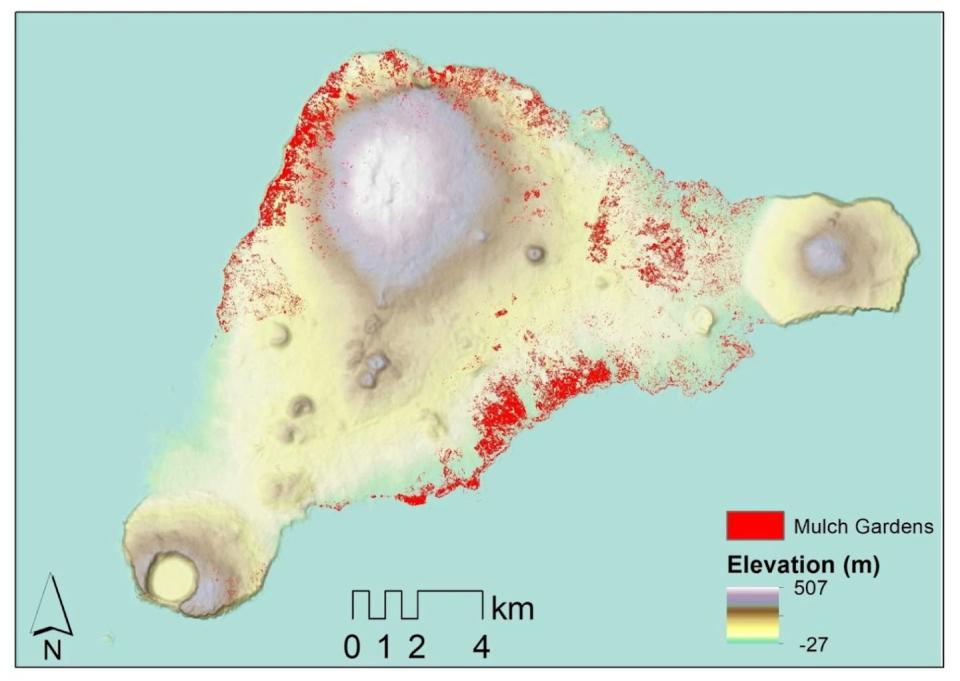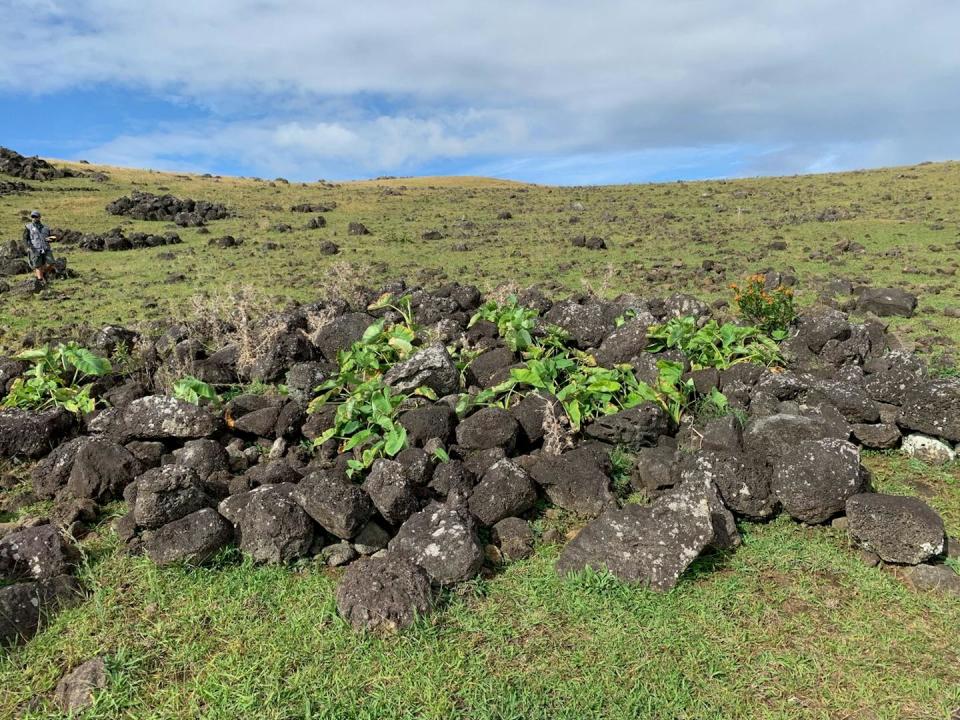Conventional wisdom holds that the island of Rapa Nui, also known as Easter Island, once had a large population that crashed after living beyond their means and robbing the island of resources. A new study my colleagues and I conducted has given this idea another blow by using artificial intelligence to analyze satellite data about piles of rocks on this small island in the middle of the Pacific Ocean.
Our research looked at rock gardens, a form of subsistence farming, and found that the island – just 15 miles (24.6 km) long and 7.5 miles (12.3 km) at its widest point – was probably never inhabited by many more than about 3,000 people. European explorers met in 1722.
The conventional wisdom grew out of speculation about another set of stone structures on the island: the iconic massive statues called moai that ancestors of Rapanui people carved. The statues tower as high as a three-story building and weigh up to 70 tons. There are almost 1,000 of them spread across the island.
To an archaeologist, the mystery of why people invested so much time and energy in building these colossal figures requires an explanation. My colleagues and I have been looking for it for the past 24 years.
Some of the first European visitors assumed that the island must have hosted a much larger population at one point to take into account the number and size of the moai. This assumption has been repeated for generations and is the basis of a collapse story.
The story of the collapse implies that the island must once have had tens of thousands of inhabitants who were needed for the work involved in carving and transporting the enormous statues. Such a large population was not sustainable, and eventually food shortages resulted in famine, warfare, and even cannibalism. As a result, the population declined to the meager numbers observed by early European explorers.

In our previous studies of the island, my colleagues and I wondered: If so many people lived on the island at some point before European arrival, where is the evidence? We conducted a new study to investigate whether such a large population was possible given how Rapanui people used rock gardens to grow much of their food. Based on our review of the available data, our best estimate is that there were never more than 3,000 to 4,000 people and that they lived sustainably on the island.
What rocks say about agriculture
In this study we examined the archaeological evidence of how the Rapanui used rock gardening to grow their main crop, the sweet potato. Rock gardening is a form of cultivation in which broken pieces of rock are added to the soil to enrich it. Extensive rock garden plots are found throughout the island which would have provided a crucial food source, supplemented by marine resources.
Previous studies have noted the size of these gardens and concluded that these efforts could have potentially supported as many as 16,000 people. However, our fieldwork revealed that many of the areas identified as rock gardens in this study were incorrectly identified. So we had to do a more detailed analysis to get a better estimate of rock gardening, which would give us a more reliable source of information about the maximum possible population sizes.
We combined fieldwork with new analyzes of satellite images. During our fieldwork we searched the ground for clear examples of rock gardening. We knew we were in rock garden locations when we found areas covered in rocks in places that could not easily be explained as due to erosion. Obsidian artifacts among the rocks confirmed that the areas were used for cutting and processing sweet potatoes. Often growing in these areas is another root crop, taro, which continues to grow even today. We also identified places that may have looked like rock mulch gardens, but were just bedrock outcrops or randomly scattered cobbles and boulders.
We then acquired WorldView-3 satellite images of the entire island. The WorldView-3 satellite collects high-resolution visible light photographs of the Earth’s surface and images that record shortwave infrared information. Shortwave infrared includes wavelengths ranging between 900 nm and 2,500 nm, longer than visible to the human eye. Shortwave infrared is useful for distinguishing materials that look identical to the naked eye. Shortwave infrared in particular is sensitive to differences in moisture, an essential characteristic of productive agricultural fields.
Using our field data, we trained machine learning models to distinguish rock mulch garden areas from areas that are not. Machine learning generates an algorithm that can detect subtle differences – and do so repeatedly and systematically. This way we could quickly survey almost the entire island, without having to do years of field mapping.


Our analyzes dramatically reduced the total area of the island that could be associated with rock gardening, from a range of 4.3 to 21.1 square kilometers to 0.76 square kilometers. When we entered estimates for the productivity of these areas, our calculations showed that the maximum number of people this form of cultivation could support is approximately 3,000, similar to the conclusions we drew from other sources of information.
Resilience instead of pride
Over the past twenty years, researchers have collected important new evidence about the archaeological finds of Rapa Nui, helping to reframe the island’s story away from the idea of collapse. For example, my team’s research shows that the statues were moved on foot from the quarry to their final location on platforms called ahu. We also tackled the question of how the islanders placed giant multiton hats called pukao on the tops of these statues.
However, the idea that there were much larger numbers of people on the island remains embedded in academic and popular literature. The persistence of this idea has implications beyond the field of Rapa Nui archaeology. For example, despite archaeological evidence to the contrary, it is not uncommon for ecologists to use Rapa Nui as a case study of so-called Malthusian demography, in which the population is believed to have reached a massive peak that temporarily exceeded the island’s resources and caused an ecological catastrophe.
While my colleagues and I agree that it is essential to be concerned about the potential for natural resource exploitation, catastrophe is not the only possibility. Human history provides many examples that demonstrate how it is possible to live sustainably despite limitations.
On Rapa Nui we learned that the population did not experience a population decline before the arrival of the Europeans, but instead succeeded thanks to their ingenuity. Rapanui people found clever ways to adapt to the island and practiced sustainable agriculture to support their livelihood. This research project adds details about the capacity of rock gardens to grow food and support the island’s population.


Our increasing understanding of the island has crucial implications for the future. By learning how to thrive in a limited environment, society can adopt strategies that people used in the past. The Rapa Nui archaeological record points to the idea that efforts that bring communities together in cooperative and competitive ways, such as moai carving and transportation, lead to greater resilience in times of shortage.
Ultimately, Rapa Nui’s history is not a cautionary tale, but a source of inspiration that could hold the key to humanity’s future.
This article is republished from The Conversation, an independent nonprofit organization providing facts and trusted analysis to help you understand our complex world. It was written by: Carl Lipo, Binghamton University, State University of New York
Read more:
Carl Lipo receives funding from the National Science Foundation and the National Geographic Society’s Lasting Impact: Archeology of Sustainability Program.